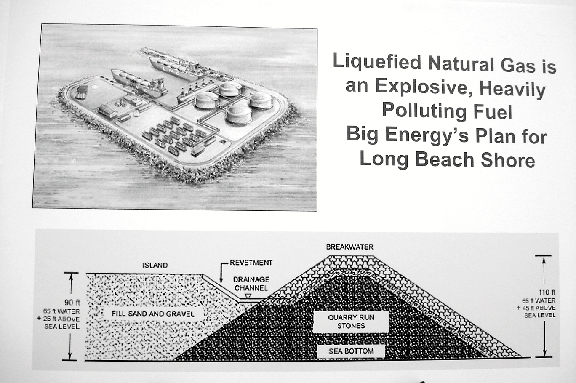Liquified Natural Gas terminal not forgotten in Long Beach
Energy experts offer their take
More than a year after the last public hearing in Long Beach, the proposed offshore liquefied natural gas terminal is still on the minds of residents, as politicians have continued to denounce its potential construction.
On April 29, a week after New Jersey Gov. Chris Christie voiced his opposition to the plan to build the terminal, which would be 13 miles south of Long Beach, Nassau County Legislator Dave Denenberg (D-Merrick) held a press conference on the boardwalk at Riverside Boulevard to applaud Christie’s decision. Joined by Long Beach City Councilman Mike Fagen and members of the Long Island Surfrider Foundation and the Freeport Tuna Club, Denenberg called the announcement a victory for the oceans.
The 116-acre island, which would serve as a port for the conversion of liquefied natural gas to natural gas, must be approved by the governors of both New Jersey and New York state. Gov. David Paterson has not made any statements about the proposal.
The project has been in the works since August 2007, when Atlantic Sea Island Group submitted an application to build the terminal to the U.S. Coast Guard and the U.S. Maritime Administration. Since then there has been a series of public hearings, the last of which was on Jan. 29, and the compilation of information to create an environmental impact statement.
Cheron Wicker, a spokeswoman for the Maritime Administration, said that the environmental impact statement is not complete, and she could not provide a time frame for when it would be released to the public. Once it is published, another public hearing will be scheduled.
Those voicing opposition to the plan seemed most concerned that it would increase dependence on foreign fuel, create the potential for an offshore catastrophe and negatively impact both the marine and coastal environments.
“The answer to the multiple-choice energy supply question cannot be none of the above,” said John Cameron, managing partner of Cameron Associates, an environmental engineering firm based in Manhattan that has no stake in the project. Cameron, who is also the chairman of the Long Island Regional Planning Council, said that the group is working on a sustainability plan for Long Island covering the next 25 years. “We’ve ascertained that we absolutely need to diversify and increase our energy supply for Long Island,” he said.
Cameron, who did not offer an opinion on the project, said that if Long Islanders want to continue to use energy, they need to have an open mind about all alternative proposals, including an LNG island.
He said he agrees with the argument that the island would increase the supply of energy and in turn decrease the cost of electricity. “It’s simple economics,” he said. But Cameron admitted that as an engineer, he has many technical questions about the project.
The ongoing cleanup effort in the Gulf of Mexico in the wake of the BP oil spill on April 20 has focused renewed attention on the potential environmental impact of any offshore project. But Greg Sachs, former engineering instructor at the U.S. Merchant Marine Academy, says LNG does not spill like oil. “Natural gas is liquid only at very low temperatures,” Sachs explained. “It would likely sit on the surface of the water and boil off.”
Sachs, a Long Beach resident whose background includes working in alternative energy, said that the chances of a spill are unlikely. And according to the Federal Energy Regulatory Commission, “In the past 40 years there have been more than 33,000 LNG ship voyages without a significant accident or [breech in] cargo security.
Another possible benefit of the project is the creation of jobs in the construction and staffing of the terminal, Sachs said, along with the crews needed to operate the ships that would transport the LNG. “It certainly has the potential of bringing seaman jobs to the region,” he said.
Like Cameron, Sachs acknowledged that there are plenty of questions that must be answered before any such project should be approved, including how it would be built and what impact it would have on the surrounding area.
“It’s a great teachable moment,” said Cody Onufrock, a Long Beach resident and an environmental science teacher at Long Beach High School. Onufrock said he has discussed the project with his students, many of whom are surfers and have a vested interest in what happens offshore.
Onufrock, who was at the public hearing last year, said that unless changes are made in our daily lives to reduce our energy consumption, the increased demand will require more energy — and infrastructure to produce it. “If we don’t really work drastically to reduce energy consumption in general,” he said, mentioning people who insist on keeping 3,000-square-foot home at 70 degrees all year round. “There’s really nothing people can say about these things popping up,” he said.
Sari Zeidler contributed to this story. Comments about it? JKellard@liherald.com or (516) 569-400 ext. 213.

 48.0°,
Overcast
48.0°,
Overcast 




